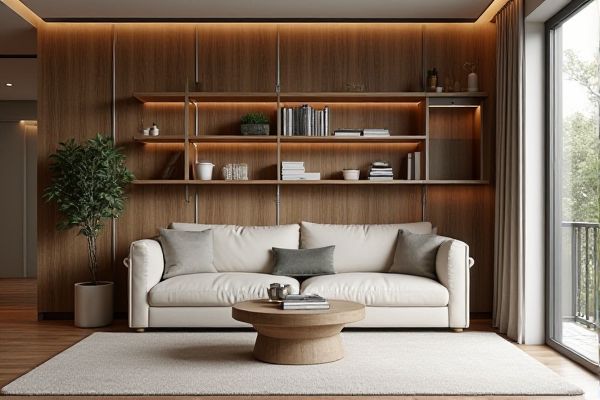
Compact storage on your terrace maximizes space by providing enclosed compartments that protect items from weather, while open shelving offers easy access and a more casual aesthetic ideal for displaying plants or decor. Discover which option best suits your outdoor needs and style by reading the full article.
Table of Comparison
| Feature | Compact Storage | Open Shelving (Terrace) |
|---|---|---|
| Space Efficiency | Maximizes storage in limited area | Requires more space, less dense storage |
| Accessibility | Items are enclosed, may require opening | Easy access, items visible and reachable |
| Weather Protection | Enclosed, protects from dust and moisture | Exposed, needs weather-resistant materials |
| Aesthetic Appeal | Neat and organized appearance | Open design, can be decorative |
| Cost | Generally higher due to enclosure | Lower cost with basic materials |
| Maintenance | Less frequent cleaning needed | Requires regular cleaning and upkeep |
| Ideal Use | Storing sensitive or fragile items | Displaying durable or frequently accessed items |
Introduction to Terrace Storage Solutions
Terrace storage solutions offer a balance between compact storage and open shelving, each catering to different space and accessibility needs. Compact storage maximizes space efficiency by using closed cabinets or storage boxes, protecting your items from weather and dust. Open shelving, on the other hand, provides easy access and display opportunities, enhancing the terrace aesthetic while organizing plants, tools, or decor.
Defining Compact Storage for Outdoor Spaces
Compact storage for outdoor terraces maximizes space efficiency by utilizing sleek, enclosed units that protect belongings from weather while maintaining a tidy appearance. These storage solutions often feature weather-resistant materials such as treated wood, metal, or high-density plastics designed to withstand UV exposure and moisture. Compared to open shelving, compact storage offers enhanced durability, security, and a clutter-free aesthetic, making it ideal for small terraces and urban outdoor environments.
Understanding Open Shelving on Terraces
Open shelving on terraces enhances spatial efficiency by providing easy access to plants, decor, and gardening tools while maintaining an airy, uncluttered atmosphere. Unlike compact storage, which confines items within cabinets or boxes, open shelving supports natural light penetration and airflow, crucial for plant health and terrace aesthetics. Selecting durable, weather-resistant materials for open shelves ensures longevity and functional appeal in outdoor terrace settings.
Space Optimization: Compact vs Open Shelving
Compact storage maximizes terrace space by utilizing enclosed units that stack vertically or fit into corners, reducing clutter and providing organized, hidden storage. Open shelving offers easy access and visual openness, but occupies more space and can create a less streamlined appearance. For efficient space optimization, compact storage is ideal in small terraces, while open shelving suits larger areas where display and ambiance are prioritized.
Aesthetic Appeal: Minimalism vs Display
Compact storage on your terrace offers a minimalist aesthetic, keeping spaces clutter-free and streamlined, which enhances a clean and modern look. Open shelving emphasizes display, allowing you to showcase plants, decor, and accessories, creating a visually dynamic and personalized ambiance. Choosing between the two depends on whether you prefer simplicity and order or a vibrant, decorative presentation.
Accessibility and Organization in Terrace Storage
Compact storage units on terraces maximize space efficiency by keeping items neatly enclosed and protected from weather, ensuring easy access through organized compartments. Open shelving offers immediate visibility and quick retrieval of frequently used items but requires consistent upkeep to maintain order and prevent clutter. Choosing between the two hinges on balancing accessibility with the need for organized, weather-resistant storage solutions tailored to terrace environments.
Weather Protection: Secured vs Exposed
Compact storage on terraces offers superior weather protection by fully enclosing items, preventing damage from rain, wind, and UV rays. Open shelving, though easier to access and aesthetically pleasing, leaves belongings exposed to the elements, increasing the risk of wear, rust, and mold. Choosing secured compact storage ensures durability and longevity for outdoor tools and furniture in varying weather conditions.
Maintenance and Durability Considerations
Compact storage units for terraces typically offer enhanced protection against weather elements, reducing maintenance needs and increasing durability by preventing dust, moisture, and UV damage. Open shelving, while providing easy access and aesthetic appeal, requires frequent cleaning and may suffer from faster material degradation due to constant exposure to rain, wind, and sun. Choosing weather-resistant materials such as treated wood, metal with rust-proof coatings, or high-density polyethylene improves longevity for both storage options.
Cost Comparison of Compact Storage and Open Shelving
Compact storage solutions typically require a higher initial investment due to enclosed designs, specialized materials, and space-saving mechanisms, whereas open shelving generally offers a lower-cost option with simpler construction and installation. Maintenance costs for compact storage can be higher over time, given potential repairs to moving parts and closure systems, while open shelving demands minimal upkeep but may necessitate more frequent cleaning to manage dust and exposure. Overall, compact storage tends to be more expensive upfront and in maintenance, but it maximizes space efficiency, whereas open shelving is cost-effective with ease of access but less protective for stored items.
Choosing the Right Storage for Your Terrace
Compact storage options maximize space efficiency on terraces by providing enclosed compartments that protect items from weather exposure and pests. Open shelving offers easy access and visibility, making it ideal for frequently used items and decorative plants, but requires weather-resistant materials to prevent deterioration. Selecting the right storage depends on terrace size, usage patterns, and exposure to environmental elements to balance functionality and aesthetics effectively.
 homyna.com
homyna.com